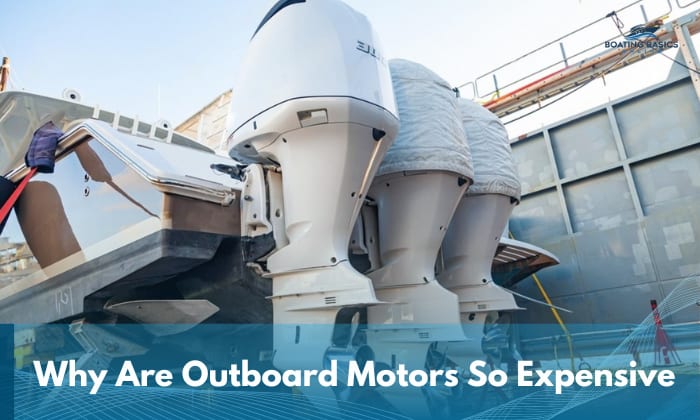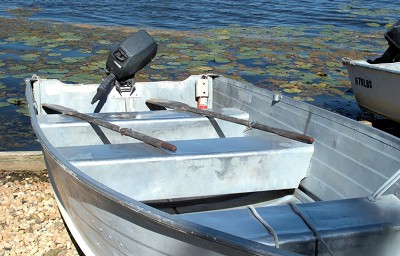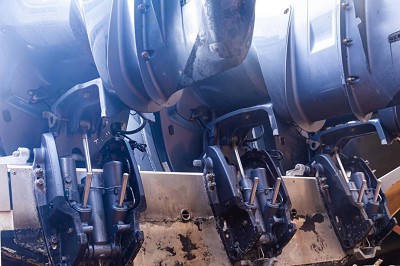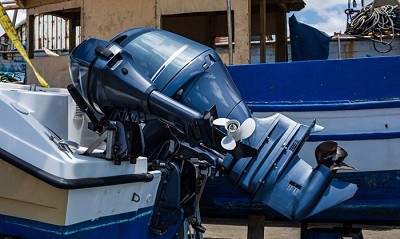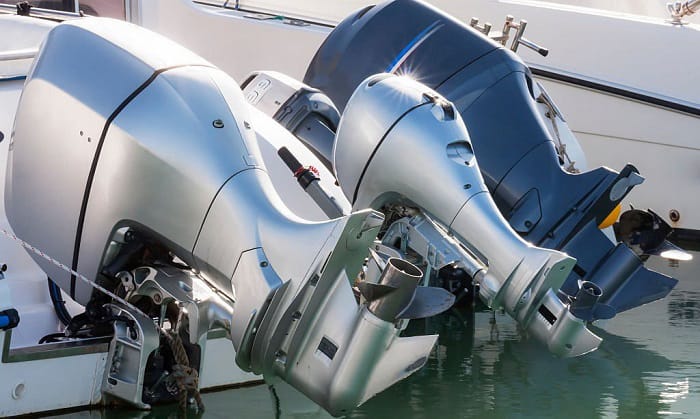Let me guess, you’ve been browsing for a new outboard motor lately, and one of the first things that entered your mind is “Why are outboard motors so expensive?”
Well, they’re likely going to stay pricey because various factors come into play, namely:
- Engine’s size and horsepower
- Materials and manufacturing and labor costs
- Fuel efficiency
- Environmental regulations
- R&D and innovation
Table of Contents
The Factors Contributing to the Cost of Outboard Motors
1. Engine size and horsepower
We can say the same for any kind of engine, really. Larger motors require more resources (both manpower and materials) to build. To enjoy these more robust powerhouses, consumers will have to cover the usually immense cost to put them on the market.
This is why the cheapest one you can buy is a used outboard motor with just around 2 horsepower (although that would likely only be able to power a homemade 10-foot skiff). Be sure you’re not actually looking at a trolling motor, though.
2. Fuel efficiency and environmental regulations
Say what you want about outboard motors’ cost and how they compare to inboard motors, but we can’t deny that they can be fuel efficient, too. You’ll see this if you know how to throttle and trim them properly. Of course, any engine that’s able to save more fuel will have a higher initial cost.
Moreover, companies have to adhere to various environmental regulations. For example, outboard motors fall under the spark-ignition category. The US Environmental Protection Agency already has clear guidelines in place for manufacturers to minimize their engines’ exhaust emissions.
3. Materials and manufacturing costs
Making outboard motors requires highly skilled labor and the materials involved do cost a pretty penny. Two good examples are aluminum and stainless steel. Based on price trends of both, here’s what I discovered:
- Aluminum prices reached their peak in March of 2022, selling for $3,498/mt. It dipped to $2,300/mt in 2023 but hasn’t gotten back to its lowest (in recent years), which was $1,500+/mt in 2020.
- Stainless steel prices, on the other hand, have been steadily rising each year based on manufacturer data.
The technology used in the manufacturing process may have advanced enough to eliminate two or more steps and limitations that would have been an integral part of it a decade ago. Even so, it’s still a relatively complicated procedure that requires synergy between assembly teams.
This Mercury outboard factory exhibition should give you an idea of what I’m talking about: Factory tour of Mercury Manufacturing in Fond du Lac, Wisconsin
Outboard motors are highly complex beasts, in short, which are altogether rare compared to other engines out there. Of course, the more limited something is the heftier its price tag.
4. Innovation and research and development
Outboards are relatively new technology. As such, they require consistent research and testing, which can balloon in costs, especially as both are long-term endeavors.
These primordial technologies aren’t the norm for production yet, so they’ll cost more until they become widely adopted. Additionally, as innovation and R&D unlock new, helpful features in outboards, they will only increase the motors’ value and demand.
Some of these desirable features could include more durability, longevity, fuel efficiency, better performance, and less emissions.
5. Brand and reputation
Certain brands of outboard motors have luxury tied to them, particularly those that are being used in the more recent compact mega yachts. For reference, the most expensive outboard motor costs upward of $100,000 – you can already buy solid Chaparrals, Sea Rays, and Benningtons with that kind of money!
All in all, you can expect more reputable brands to have a higher asking price than their lesser-known counterparts.
Top Brands in the Industry
When we mention outboards, these are the brands that immediately come to mind for boaters and experts alike. Apparently, Japanese brands have quite a monopoly in the industry.
- Yamaha – it’s pretty much been a rivalry between Yamaha and Mercury when it comes to outboards. You can’t go wrong with this brand’s advanced design, unsurpassed power, fuel efficiency, and overall reliability – all available in two-stroke and four-stroke varieties.
- Mercury – recognized for its innovative designs, reliability, and superior durability, this brand’s outboards are just as lauded for its features integration. Precise and responsive controls and acceleration pair well with throttle response and optimal fuel economy.
- Evinrude – Evinrude outboards stand out with their two-strike engine’s fuel economy and efficiency and pride themselves on having the lowest emissions in the industry.
- Honda – for overall reliability in fulfilling hefty loads and challenging environments, Honda outboard motors have become a preferred choice among boat builders despite limited parts availability.
- Suzuki – high quality, reliable, and long-lasting – these are but some of the characteristics tied to Suzuki outboard motors. Their four-stroke models arguably rival Mercury’s in terms of smooth acceleration, steady performance, excellent torque, and fuel economy.
Comparison With Inboard Motors
In the context of boat engine price, we need to look at the following facts when deciding whether outboards are better than inboards and vice versa.
- Inboard motors tend to have better longevity than outboard motors.
- Outboards set you back more in the long run as they tend to require more frequent maintenance. However, inboard engines may have higher maintenance costs every time you take them to a service.
- Outboard engines have a higher selling price – although the difference may be negligible in some cases.
- Inboard motors may have more horsepower, but they may still cost cheaper than an outboard with less horsepower.
Renting Vs. Buying
With the factors above making boat engines so expensive, wouldn’t renting be a logical step for boaters who still want to experience what they bring to the table? Let’s find out.
- When deciding whether to rent a motor or an entire boat for that matter, there’s only one approach to it. If you’re only going to boat or fish on a short-term or occasional basis, then renting the way to go.
- Rental fees will only add up over time. Still, it’s not like you’d be spared from running costs once you decide to purchase, with maintenance and storage costs being the unavoidable ones.
- Buying makes the best sense for long-term endeavors. You can always cut the initial costs significantly by looking for a well-maintained used vesse
- Owning an outboard motor gives you the freedom to personalize it, like giving it a custom cover or increasing its horsepower more.
Market Trends and Future Outlook
The future of the outboard motor industry is bright, to say the least. The projected compound annual growth rate (CAGR) of the industry between 2022 to 2030 is 11.48%. It’s estimated to become a $243 million dollar industry by 2030.
Clearly, the demand is there, not only in recreational and commercial pursuits but in the military as well. It doesn’t hurt that electric outboard motors are a bona fide sustainable option, and as recent years have proven, the sustainability trend is likely here to stay and will only gain more traction over time.
Alternative Options for Boaters
- Inboard engines – not only are they more fuel-efficient, but they’re also more powerful and less noisy.
- Sail-powered – if you appreciate only hearing nothing but the wind and the water then sailing is the way to go. You can also say goodbye to motor maintenance.
- Jet propulsion – if you don’t need to go to open seas and want to stick to skiing, fishing, or wakeboarding in shallow water, you’ll get better maneuverability with jet propulsion systems.
- Electric – what they lack in power compared to their gasoline-powered counterparts, they more than make up for in eco-friendliness, peace, and quiet. They don’t eat up space, too!
- Human-powered – perfect for those who want to get a workout while doing the boating activities they love.
Frequently Asked Questions
How long do outboard motors last?
Outboard engines pricing is justified by the fact that the average motor is expected to last for at least 7 or 8 years or 1,500 hours. If you don’t skimp on maintenance, you’ll likely enjoy longer usage.
What size outboard motor do I need for my boat?
Base it mostly on the weight. You will likely need to add 1 horsepower for every 30 pounds of weight – others say it should be per 40 pounds. It shouldn’t be that strict on the whole.
That means if you have a watercraft weighing exactly 900 pounds, you’ll need a 30HP outboard (following the former guideline).
What maintenance is required for outboard motors?
The most essential steps that you can’t omit are checking each vital component for damage and making sure that each one is still working as it should. This applies to the fuel lines, fuel tank, vent, fittings, primer bulb, and other fundamental parts your specific outboard engine may have.
Conclusion
I hope I’ve made the answer to “Why are outboard motors so expensive?” clear with the facts shared here. Overall, prices are influenced by the sheer complexity of creating these contraptions from scratch, the equally pricey materials, and the ongoing efforts being done to further hone their capabilities and features.
The future of outboard motor manufacturing remains bright, but boaters will have to live with the fact that they’ll likely enjoy marginal discounts in the next few years or decades.
Read more: Outboard vs sterndrive: what should I choose?

“My intention from the first day establishing Boating Basics Online is to provide as much help as possible for boaters who want to experience a first safe and convenient trip. So feel free to join us and share your beautiful journeys to the sea!”

